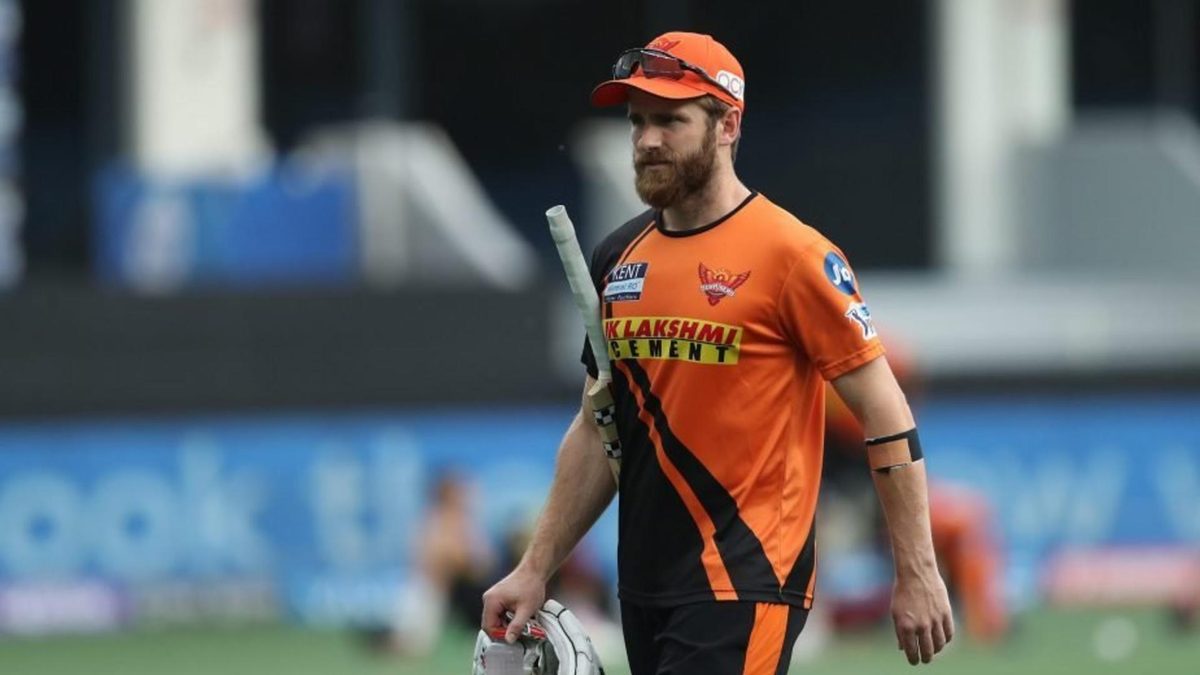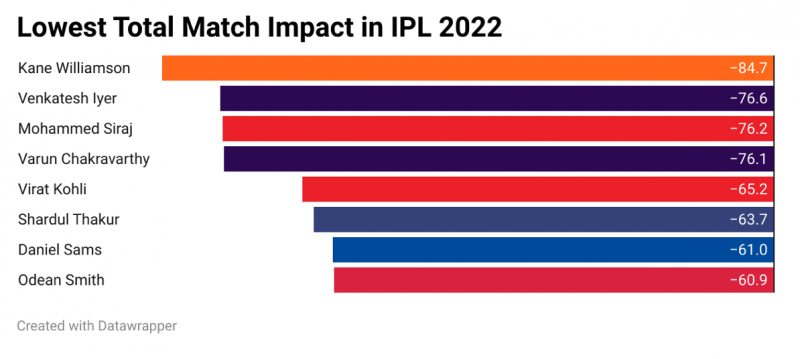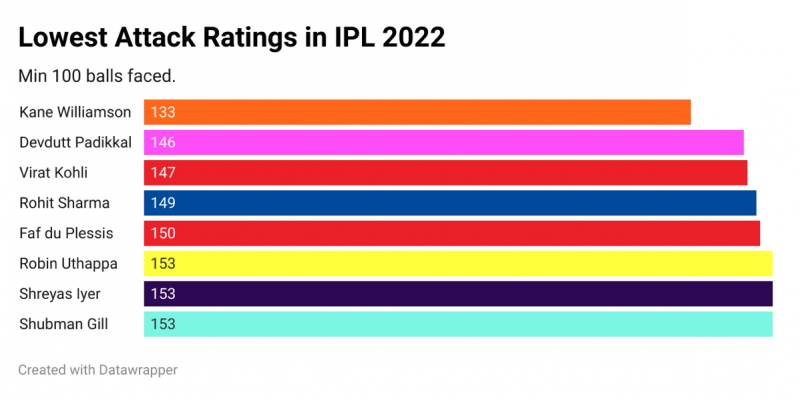
CricViz’s Ben Jones examines the numbers behind a historically poor season from one of the modern greats of the game – Kane Williamson.
Sign up to bet365 across the IPL, to be entered into a draw for the chance to win a Wisden poster of your choice, terms and conditions apply, more information here. 18+ begambleaware.org
Sunrisers Hyderabad are having a strange old season. Post-auction, many felt that their squad was well rounded and balanced, but lacked that touch of quality in key areas, and that Tom Moody et al had failed to replace the star dust of the departing David Warner and Rashid Khan. Their season then began with a number of defeats, the rot seeming to have set in. A burst of form from Rahul Tripathi and youngster Umran Malik then turned things around, a journey up the table and towards play-off contention.
On the one hand, a sequence of excellent luck with coin tosses – with nine correct calls out of 10 – has given them a healthy boost. But on the other hand, the man calling correctly has been one of their major problems.
Sunrisers skipper Kane Williamson is having a shocker of a season. 10 innings have brought 199 runs, at less than a run a ball, with just one trip north of 50. His Total Match Impact this season is -85, the worst of any player in the tournament. He’s hit fielders, but never a run of form.

In one of the highest scoring IPL seasons in history, Williamson is at odds with the vibe. His Attack Rating of 133 is the lowest of anyone in the tournament, and while his role in this particular SRH side is a classical anchor, that level of aggression is unsustainable. In a ‘normal’ season of home and away fixtures, then slower, tougher batting conditions at the Rajiv Gandhi Stadium could excuse such a high level of caution, the group of high-scoring venues hosting IPL 2022 negates Williamson’s strengths, and exaggerates his weakness.

In particular, it’s been his Powerplay returns which have been so dreadful. 101 runs from 127 deliveries, averaging only 17, is a level of under-performance that few teams could cope with. No batter in IPL history has scored slower in the Powerplay having faced so many deliveries across a season – Williamson’s season is historically, exceptionally poor. Of all the instances where a player has made 10-plus appearances in a single IPL season, Williamson’s 2022 campaign is third worst. While his returns have been middling (at best) in T20 for a while now, nobody could have anticipated things dipping to quite this level.
Ahead of this season, before this collapse, Williamson’s retention still stood out, particularly when placed alongside the loss of Rashid. The Afghan – well on track to be the best T20 player of all time – was seemingly reluctant to stay for anything other than the top salary rank, a reasonable request given his standing in the game. It does nobody any good to speculate on the internal politics of a dressing room, but it is very difficult – impossible even – to explain why a 31-year-old anchor with a mediocre IPL record was retained over a much younger elite bowler. There will be a reason. It’s hard to know what it could be.
Maybe it was an appeal to history. The last time that Sunrisers found themselves left in the lurch after a David Warner-induced crisis, in 2018 they appointed Williamson as captain, and subsequently reached the final. Unshakeably calm, the Kiwi is a good man to lead you through a period of instability, and after last season that’s where SRH found themselves. They have looked to recreate a previous escape.
Equally, you could say that the “choice” to let Rashid Khan leave was a refusal to look at the specifics of that 2018 campaign. Williamson may have been filling big shoes, but he was leading an incredibly talented team, defined by the early greatness of Rashid. At heart, tactical nous and leadership are influential, but players win games of cricket. Signing a player for their captaincy, or rather paying a premium for that skill, is fair enough when the premium is slim. Given the reasonable expectations on Williamson’s open-market cost, his captaincy premium is more than half of his price.
The comparison with RCB, Sunrisers’ opponents on Sunday, is clear. Virat Kohli is another member of the Fab Four, another man retained on huge money after middling recent returns, and another man whose lack of attacking intent – or relative inability to attack – in the Powerplay and early middle overs has significantly hamstrung the batting order. Even as the runs have returned in the last two matches, his effect on the line-up has worsened: a match-losing half-century against Gujarat Titans was followed up by 30 (33) against Chennai Super Kings, an innings saved from a similar fate by Dinesh Karthik and a poor CSK batting effort. Kohli’s negative effect on the actual XI is less than Williamson’s by virtue of being a domestic player, but it’s not hard to see the likeness.
Similarly, the reason people keep faith and believe in both players is almost identical. Aside from the dried out trust in reversion to the mean – a suit and tie on the idea of being “due a score” – there is clearly something in these two players that elevates their reputations above the role players who surround them, be it a technical base, muscle-memory greatness, an indefinable aura. Streaks of good form and perfect usage can bring about excellent results but broadly, that trust in these sorts of players is misplaced.
From here, who knows. Williamson’s attacking intent can improve with a blend of tactical tweaks and individual responsibility, but it doesn’t mean that his form will follow. If Williamson’s form doesn’t improve, then judgement of his performances is entirely subsumed into that of the team; make the play-offs and his inspirational captaincy brought together a rag tag group, but fail and his output is unacceptable for a 14cr player of his experience. The latter would put Moody et al in a tricky situation, particularly with Nicholas Pooran’s ascension to the West Indies white-ball captaincy. Suddenly, there are alternatives.
Yet clearly, the best scenario for both sides is that Williamson improves. There is no chance that any other franchise would be willing to sign him at his current price, perhaps even at all; releasing their captain would be an enormous climb down for the SRH brains trust. There is a genuine connection between Williamson and this side, this set-up, and for a franchise at the unfashionable end of the spectrum, that’s valuable. This is a mutually ideal relationship where, in the words of the poet Crispin Best, ‘they like each other, and vice versa’. That reciprocal trust might have led SRH to make some less than optimal decisions with their recruitment, but it might also offer Williamson the time he needs to recover his form and deliver.
For all the analysis, data, and cold hard facts – what price loyalty?








